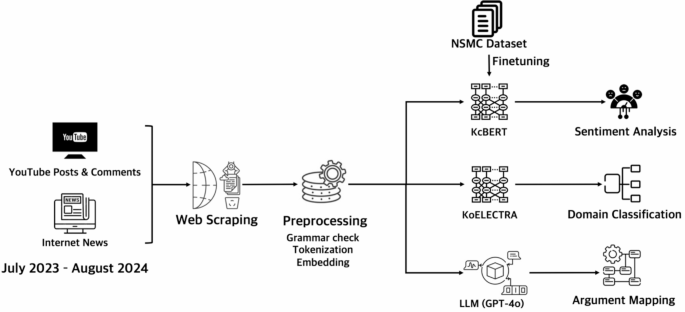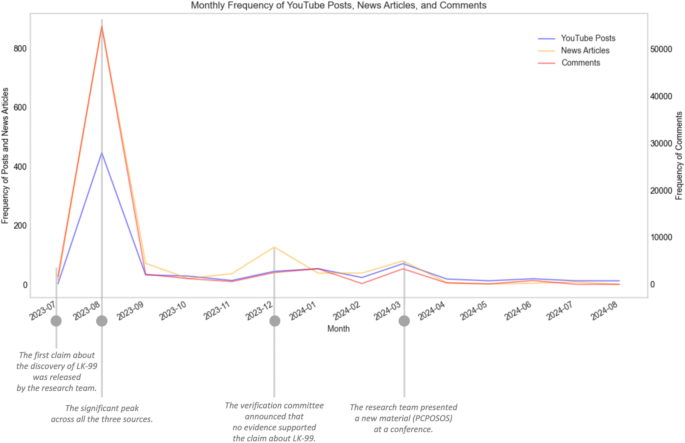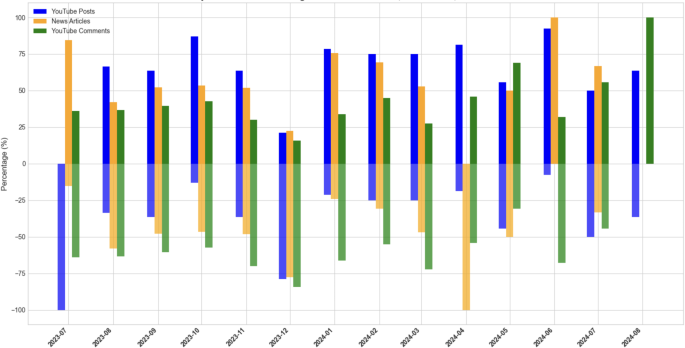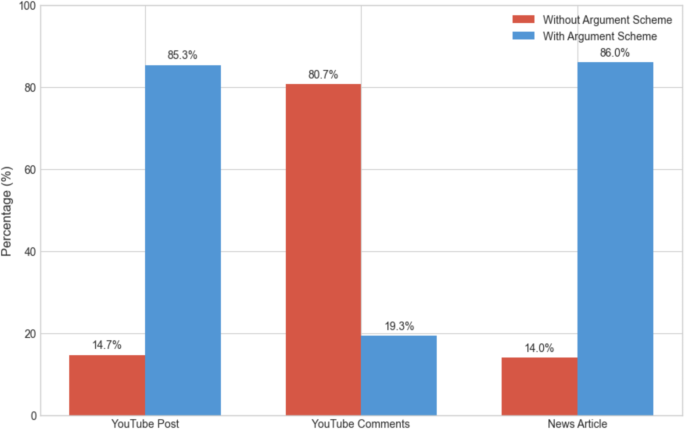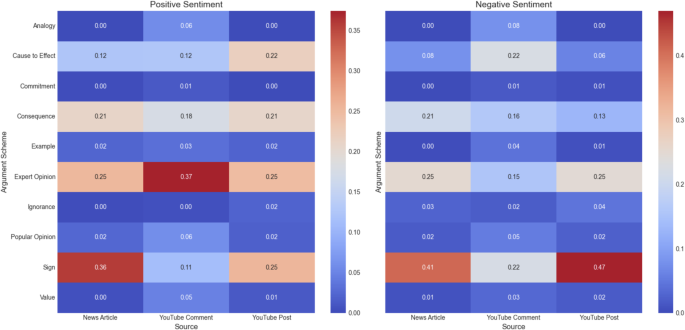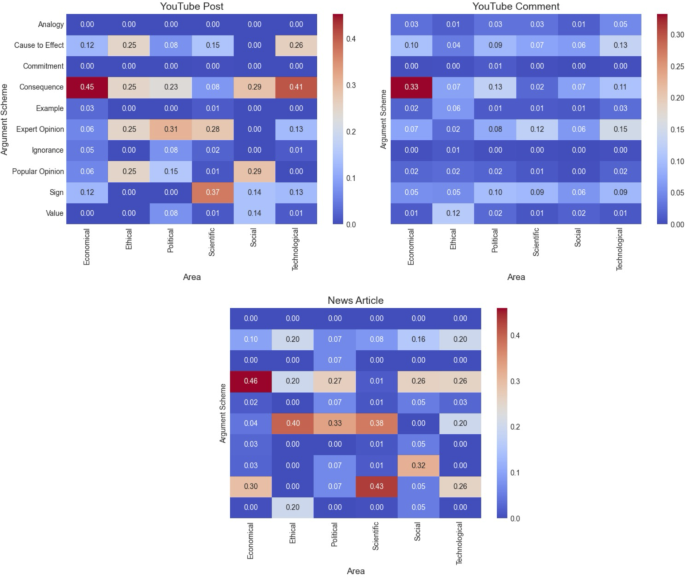Trend of three different sources
Our analysis of frequency trends reveals that the number of posts surged in conjunction with key events but generally declined. Figure 2 illustrates the number of news articles (orange), YouTube Posts (blue), and comments (red) published online from 23 July 2023 to 23 August 2024. This dual-axis bar chart uses the left axis to represent the number of news articles and YouTube Posts, and the right axis shows the number of YouTube comments. When the first claim about the discovery of LK-99 was released in July 2023, there was a significant peak across all three categories: 874 news articles, 446 YouTube Posts, and 54,771 comments were published in August 2023. However, these numbers sharply declined after August and continued to drop until October 2023. Toward the end of 2023, there was a slight increase across all three categories, followed by another decline after the start of 2024. Although a modest rise was observed in March 2024, the overall posting frequency remained relatively low for all three groups through mid-2024. These temporal trends provide essential context for our analysis, as they help explain how fluctuations in discourse volume are associated with shifts in public sentiment and argumentation patterns over time, which is critical for understanding the evolution of public engagement with the LK-99 controversy.
Monthly count of news articles, YouTube Posts, and YouTube comments.
The three groups’ posting frequencies commonly rebounded in December 2023 and March 2024, indicating that specific events related to LK-99 took place at these time points. On December 13, 2023, the Korean Society of Superconductivity and Cryogenics Verification Committee announced that no evidence supported the claim that LK-99 is a room-temperature, ambient-pressure superconductor. Since August 2023, the committee had been conducting verification procedures—obtaining samples of LK-99 from the Quantum Energy Research Centre and performing cross-measurements and replication studies based on methods outlined in the preprints. As a result, they concluded that LK-99 does not exhibit superconductivity at either room temperature or low temperatures, instead behaving as a non-superconductor with significant electrical resistance. Our content analysis of news articles, YouTube posts, and comments indicates that discussions focusing on these verification results became notably more frequent in December 2023. Later, On March 4, 2024, the Quantum Energy Research Centre research team presented a material called PCPOSOS at the American Physical Society. They claimed that this new material—created by adding sulfur to LK-99—exhibits room-temperature and ambient-pressure superconductivity. During the presentation, the research team detailed how the addition of sulfur altered LK-99, contrasting with the earlier findings of the Verification Committee. This announcement triggered another wave of discussions, as reflected by a surge in news articles, YouTube posts, and comments addressing the conference presentation and the new claim.
In addition to overall posting trends, our analysis of channel-level characteristics reveals notable differences between legacy and new media. A supplementary table (Table 1) summarizes key metrics—such as content frequency, average view counts, and likes—across channels, with legacy media (media = 1) generally exhibiting higher engagement than new media (media = 0). In our analysis, we considered only legacy media (i.e., the science channel or legacy media) as the expert group. These channel-specific differences may partly explain the variations observed in sentiment and argumentation patterns across our dataset. For instance, channels with higher engagement tend to feature more structured discourse and positive sentiment, which is reflected in our subsequent sentiment and argumentation analyses.
Table 1 Top 10 channels by content frequency and engagement metrics.
To further explore how attention is distributed among different types of content creators, we examined the top 20 channels ranked by total likes and views for LK-99-related videos (Table 1). Among these channels, only three specialize in science, and two represent traditional legacy media, while the majority do not appear to have a direct focus on scientific reporting. In the analysis, we considered only these types of channels experts’ content. Although legacy media channels produced a considerable amount of LK-99 coverage, non-specialist channels collectively garnered higher view counts and likes, suggesting that producing a large volume of content or having recognized expertise does not necessarily guarantee high engagement. Notably, the top 20 channels accounted for only 12.58% of the total LK-99-related videos but attracted 75.95% of all views and 77.98% of all likes—indicating a strong concentration of audience attention. These findings raise questions about how effectively scientific information is communicated and received on social media platforms, particularly when a significant portion of engagement is driven by channels without a clear science focus.
Sentiments
Our sentiment analysis of the three group posts shows that their sentiment orientations often exhibited similar trends during certain periods, but sometimes they displayed very different patterns. We categorized their posts into three types of sentiments: positive, negative, and neutral. Neutral sentiment posts did not include emotional expressions. Figure 3 displays how the posts were categorized into positive and negative sentiments in a dual-axis bar chart. The vertical axis represents the percentage of monthly positive(+ y) and negative(-y) responses about each type of source. This figure illustrates sentiment orientations and fluctuations across the three groups over the two years.
Sentiments revealed in news articles, YouTube Posts, and YouTube comments.
News articles exhibited slightly positive sentiments overall but showed significant volatility. Positive sentiment peaked in July 2023 following the release of LK-99 preprints but shifted to negative in August due to skepticism from academic communities and its impact on the stock market. Sentiments stabilized from September to November 2023 but turned negative again in December when the Verification Committee refuted LK-99’s superconductivity claims. A positive trend was observed in early 2024, coinciding with new material announcements from the research team, but declined again in April when academic skepticism resurfaced. Despite fluctuations, sentiments remained predominantly positive as articles highlighted the potential technological and economic impacts of Korean superconductor research.
YouTube Posts displayed a predominantly positive sentiment throughout the observed period, with fluctuations in the proportion of positive and negative sentiments each month. Initially, a high proportion of negative posts reflected skepticism from the research community regarding LK-99. However, positive sentiments gained prominence from September to November 2023 as creators focused on the potential scientific and technological advancements of room-temperature superconductors. In December 2023, the proportion of negative Posts spiked following the Verification Committee’s conclusion refuting LK-99’s superconductivity claims. Positive sentiment regained dominance in early 2024 as creators highlighted the announcement of new materials, but a slight decline was observed in April 2024 due to renewed skepticism. Despite these variations, positive sentiments consistently outweighed negative sentiments in most months.
YouTube comments predominantly exhibited a stable proportion of negative sentiments across most months, with fewer fluctuations compared to Posts or news articles. Negative comments were common early on, as users frequently pointed out the lack of verification for LK-99’s claims and skepticism from the research community. Positive sentiment proportions increased briefly in February 2024 following the announcement of PCPOSOS, a material claimed to improve LK-99 but declined again in subsequent months. Small positive spikes reappeared in May and August 2024, reflecting optimism about the broader potential of room-temperature superconductors. However, the overall sentiment remained predominantly negative throughout the period.
Argumentation
Our analysis of argumentation schemes embedded in news articles, YouTube Posts, and comments demonstrates that these groups usually employed ten different argumentation schemes, which are listed in Table 1. The most frequently used scheme was the Argument from Sign, where conclusions were drawn based on specific signs or pieces of evidence. The second most common scheme was the Argument from Expert Opinion, in which claims were supported by referencing experts within the relevant field. The Argument from Consequences ranked third, where the appropriateness of an action or policy was judged based on its outcomes. Also, in some cases, we found posts that did not follow any recognizable argumentation scheme, and these were categorized as None. We interpreted this to mean that these posts did not involve any form of logical reasoning.
Table 2 Argument schemes used in the posts about LK-99.
Figure 4 provides an overview of whether or not identifiable argumentation schemes are present in news articles, YouTube Posts, and comments. As shown, both news articles and YouTube Posts predominantly rely on argumentation schemes—especially Argument from Sign, Argument from Expert Opinion, and Argument from Consequences—while YouTube Posts also exhibit a slightly higher use of Argument from Cause to Effect. In contrast, 80% of YouTube comments lack any identifiable argumentation scheme, with the remaining 20% occasionally employing Argument from Expert Opinion, Argument from Sign, and Argument from Consequences. Although we observed minimal use of Argument from Analogy, Argument from Commitment, and Argument from Values across all three groups, these schemes are not individually depicted in Fig. 4 due to their low frequency. If further granularity is needed—such as breakdowns of specific argumentation schemes within each platform—a more detailed figure or supplementary table may be necessary.
Comparisons of argumentation schemes among News articles, YouTube videos, and YouTube comments.
To further explore how sentiments are linked to argumentation in the posts, we analyzed argumentation schemes based on positive, neutral, and negative sentiments. Figure 5 illustrates how different argumentation schemes were used in relation to positive and negative sentiments across news articles, YouTube posts, and comments. In our analysis, we conducted correlation tests to examine the relationships between sentiment polarity and the frequency of specific argumentation schemes. Our results indicate that several of these correlations were statistically significant (p Argument from Sign and Expert Opinion, while YouTube Posts showed higher usage of Consequences and Cause to Effect. In YouTube comments, Expert Opinion was the most used scheme. For negative sentiments, Argument from Sign, Expert Opinion and Consequences dominated across all three groups, with YouTube posts showing the highest proportions for these schemes. YouTube comments also included Cause to Effect arguments more frequently in negative contexts.
Association between sentiments and argumentation schemes.
Additionally, we examined how the argumentation schemes used in news articles and YouTube Posts vary based on the sections where they are published. YouTube and online news platforms offer different sections, allowing content creators to select the most appropriate one to attract and interact with viewers who are likely to be more interested in the content. Figure 6 compares the distribution of argumentation schemes across different content sections for news articles, YouTube posts, and comments. The rows represent the ten argumentation schemes, and the columns indicate content sections (e.g., Economy, Political, Society, Science, Technology). The color scale corresponds to the relative frequency of each scheme within a given section, with red hues denoting higher usage and blue hues indicating lower usage. In news articles, scientific and economic sections prominently used Argument from Sign and Expert Opinion. The economic section also highlighted Consequences as a key argumentation scheme. YouTube posts in scientific sections mirrored news articles, frequently employing Sign and Expert Opinion. However, in technological and economic sections, they leaned toward Consequences and Cause to Effect. YouTube comments showed limited differentiation by section, though Consequences appeared more frequently in economic discussions.
Heatmaps illustrating the frequency of each argumentation scheme across different sections for YouTube posts (top-left), YouTube comments (top-right), and news articles (bottom).
